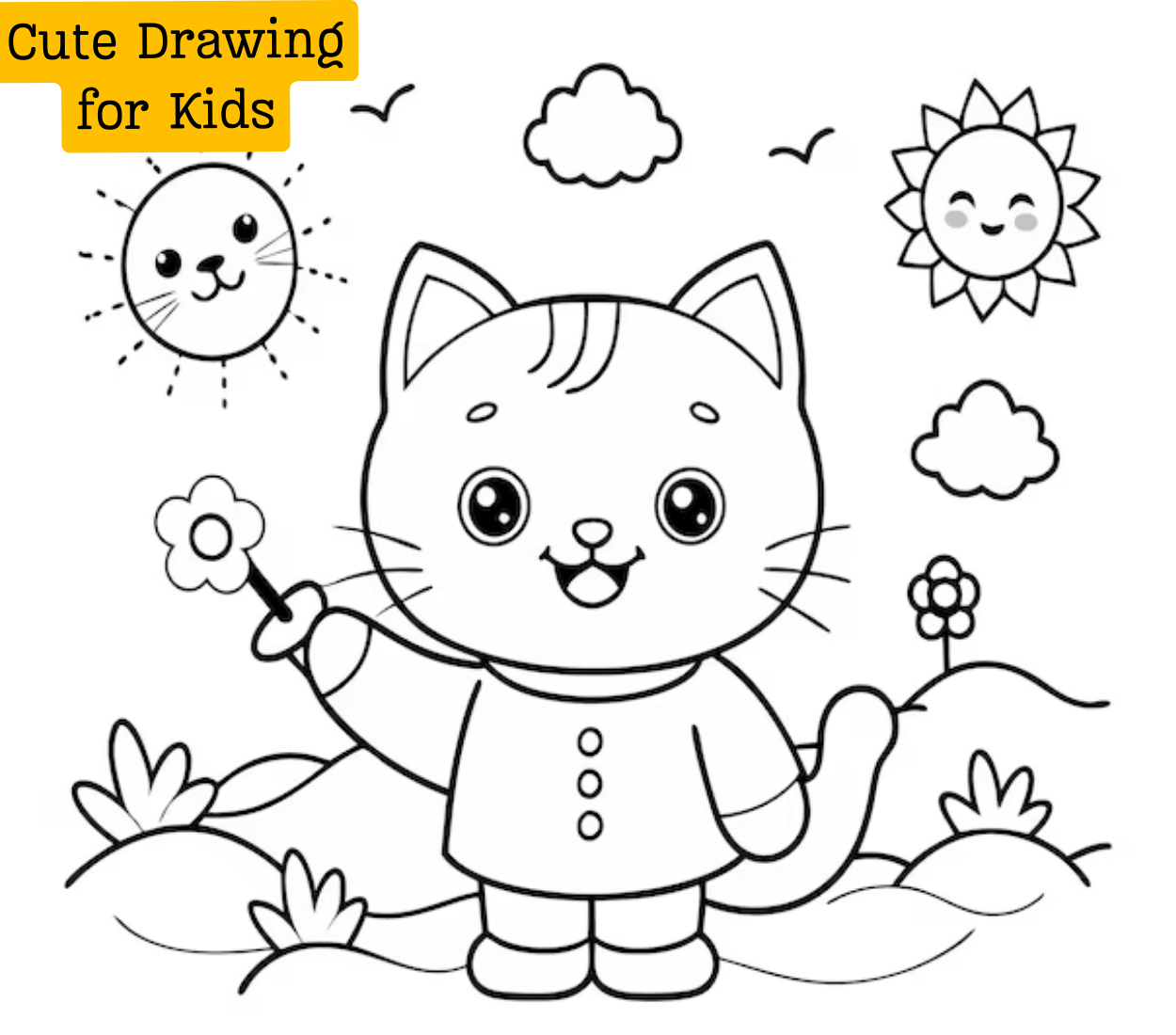Introduction
cute drawing for kidsThere’s something magical about a child’s drawing. Every little sketch, from a stick figure with an enormous smile to a vibrant rainbow stretched across the sky, tells a story. Children naturally express themselves through art, and cute drawing for kids is one of the simplest and most impactful ways for them to do so. It’s a gateway to their imagination, a mirror reflecting how they see and interpret the world.
In this article, we’ll dive into the joyful world of cute drawing for kids. Whether you’re a parent looking to nurture your child’s creativity, or a teacher planning fun classroom activities, we’ll explore easy and delightful ways to encourage artistic expression. So, let’s grab some crayons and get started on this colorful adventure!
The Importance of Drawing in Childhood Development
Drawing is not just a fun pastime; it plays a critical role in the development of young minds. From boosting fine motor skills to enhancing cognitive development, the act of drawing helps kids in multiple ways. When a child picks up a pencil to sketch, they’re not just creating lines on paper—they’re learning how to focus, solve problems, and express their emotions.
Why Kids Love Drawing: The Emotional Connection
For many children, drawing feels like magic. It gives them control over their world, allowing them to create anything they can imagine. When a child doodles a sun with a smiley face, they aren’t just copying something they’ve seen; they’re creating a universe where even the sun is happy! This emotional connection makes cute drawing for kids deeply personal and fulfilling for children. Every drawing is a reflection of their inner world, a space where everything is possible, and every character has a story to tell.
Simple Tools You Need for Cute Drawings
You don’t need expensive tools to encourage cute drawing for kids. All you really need are a few basic supplies that you likely already have at home.
Essential Tools for Kids’ Drawings:
- Crayons
- Colored pencils
- Markers
- Paper (both white and colored)
- Erasers
- Kid-friendly rulers for drawing straight lines
With these simple tools, kids can unleash their imagination and start creating wonderful art pieces.
Drawing Ideas for Beginners
Starting with Basic Shapes
The easiest way to introduce cute drawing for kids is by breaking things down into simple shapes. Circles, squares, triangles, and rectangles can form the foundation for almost anything they wish to create. This helps them see the world in a new way: a car becomes a rectangle on wheels, and a person can start as a circle for the head and lines for the body.
Turning Circles into Smiley Faces
One of the simplest and most loved drawings for kids is a smiley face. It’s just a circle with two dots for eyes and a curved line for a smile, yet it brings so much joy. You can show kids how to play with the expression by making the smile bigger or adding details like rosy cheeks.
Squares into Cute Houses
Drawing a house is often one of the first “big” drawings a child will attempt. Start with a square for the body of the house, add a triangle for the roof, and you’re halfway there! Encourage kids to add details like windows, a door, and maybe even a garden filled with flowers and butterflies.
Animal Drawing: A Child’s Favorite
Animals are a universal favorite when it comes to kids’ drawings. They’re fun, cute, and offer endless opportunities for creativity.
How to Draw a Cute Cat
Start with an oval for the body, add two triangle ears, a round head, and a swoopy tail. Don’t forget the whiskers! Drawing a cat is both simple and fun, especially when kids get creative with colors—how about a purple cat?

Drawing a Fun Elephant
Elephants may seem challenging, but breaking them down into simple shapes makes them easy and delightful to draw. Start with a big circle for the body and a smaller one for the head. Add the trunk, floppy ears, and thick legs, and you’ve got a friendly elephant cute drawing for kids!
Bringing Imaginary Creatures to Life
Why stop at real animals? Let kids stretch their imaginations by cute drawing for kids creatures that don’t exist in real life. Maybe they want to create a dragon with rainbow scales or a unicorn with wings. Imagination knows no boundaries, and the world they create is endless.
The Power of Colors in Children’s Drawings
Colors play an essential role in cute drawing for kids. Bright, vibrant colors can express joy and excitement, while darker shades might reflect more serious emotions. Encourage kids to explore the full spectrum of colors, even if they decide to make the sky green and the grass blue. It’s all part of the creative process!
Encouraging Creativity Without Boundaries
When it comes to children’s drawing, there are no right or wrong ways to create art. Allow kids to draw whatever comes to mind, without correcting or guiding them too much. Our aim is to set their creativity free, allowing their imagination to soar.
Step-by-Step: How to Draw a Simple Unicorn
Unicorns are a favorite among cute drawing for kids! Start with a circle for the head, add a long oval for the body, and of course, the iconic horn on the forehead. Once they have the basic shape, let them decorate it with stars, sparkles, and whatever their heart desires.
Making Drawing Fun with Themes
Themes can make cute drawing for kids even more fun. You could have an “Under the Sea” theme one day, where kids draw fish, dolphins, and mermaids. Or maybe a “Space Adventure” theme, where rockets, astronauts, and planets fill their paper.
Drawing Games: Sparking Joy and Learning
Turning drawing into a game can make the process even more enjoyable. You can play “Draw Something,” where one person describes something and the others try to draw it. It’s a great way to get kids thinking creatively while having fun.
The Emotional Benefits of Drawing
cute drawing for kids isn’t just about creating cute pictures; it’s a powerful emotional outlet for kids. When they’re feeling happy, sad, or frustrated, drawing allows them to express those emotions in a safe and creative way. It helps them process their feelings and communicate what they might not have the words for.
How to Praise and Encourage Young Artists
Always celebrate the effort, not just the result. Whether their drawing looks like a recognizable object or not, praising the process and creativity behind it can boost their confidence. Say things like, “I love how you used all those colors!” or “Wow, you put so much detail into this!”
The Importance of Displaying Their Artwork
Displaying a child’s artwork is a powerful way to show them that their creativity is valued. Whether you hang their drawings on the fridge or frame them in their room, it sends a message that their artistic efforts are worth celebrating.
Conclusion: Drawing as a Lifelong Journey
Cute Drawing for kids is more than just a fun activity—it’s a journey of self-expression, creativity, and emotional growth. Encouraging kids to draw helps them tap into their imagination, and it’s a gift they can carry with them for life. So the next time your little one picks up a crayon, remember that they’re not just drawing—they’re telling their story.
FAQs
What can I do to inspire my child to pick up a pencil and draw more often?
Start by providing them with simple tools and fun themes, and most importantly, praise their efforts without focusing too much on perfection.
What are some easy drawing ideas for beginners?
Start with basic shapes, like circles and squares, and turn them into smiley faces, houses, or simple animals like cats and dogs.
Why is drawing important for kids?
Cute drawing for kids helps with fine motor skills, cognitive development, and emotional expression. It nurtures their creativity while helping them develop the ability to think through challenges.
What if my child doesn’t like drawing?
Try introducing drawing games or letting them create imaginative creatures. Keep it fun and low-pressure, and they might develop an interest over time.
What are the best tools for kids’ drawing?
Crayons, colored pencils, markers, and paper are all you need to get started. Simplicity often sparks the most creativity.



